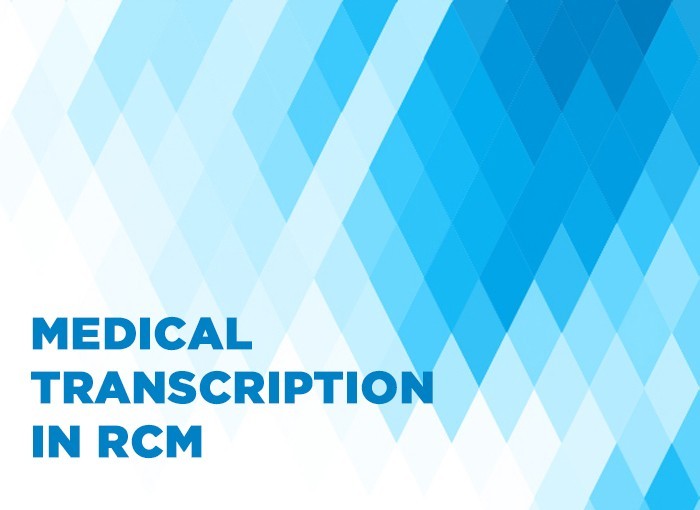What is Medical Transcription in RCM?
Healthcare is a fast-paced, dynamic industry, and therefore, maintaining financial stability becomes a challenge. Successful RCM strategies ensure that the claim moves along and you get paid for the services offered on time in order to maintain a positive account balance. The process of medical transcription plays a dynamic role in revenue cycle management. The trillion-dollar industry, offering medical assistance to patients round the clock, ensures that summary transfer gets done immediately.
What is Medical Transcription?
Medical transcription involves the manual processing of a practitioner’s or other healthcare professionals’ notes and audio files into text format. Service seems easy, but there are several strings attached to the world of healthcare. Medical transcription, also known as MT, is an integral part of ensuring precision-driven documentation with HIPAA compliance is delivered.
How does the service work?
Medical transcription is one of the factors of RCM, beyond other accurate and well-timed documentation. For instance, a patient visits his/her practitioner for a sore throat, and the doctor dictates a note about the patient’s health condition. The dictation gets captured electronically through the digital recorder or digital systems ensuring it is legal and within norms. The payment cycle is effective from the following recorded document.
Once the practitioner signs off on it, the entire document resides in an electronic medical record. Presently, medical coders interpret the recordings, summaries, notes, patient history, and other reports, and based on the content, successfully assign ICD or CPT codes. To ensure that the diagnosis codes support the medical necessity of the treatment, the transcribed document gets shared with the billing department, where the patient account managers, patient account specialists, and patient billing consultants go through the file for further processing. As per the guidelines, they submit and follow up on the claims submitted to insurers. Reimbursement and the quality of care to the patient are the driving forces in the healthcare industry.
Benefits of medical transcription thereby affecting RCM
In a field of volatility, any medical document transcribed incorrectly can cause a loss of approximately billions and will not be a good option for your RCM. Below is the list of benefits of medical transcription :
Through the latest monitoring tools, medical transcription services eliminate trivial errors and limit the hefty penalties thereby bringing positive changes to revenue cycle management.
They use their learning and experience to detect discrepancies and what needs inclusion or exclusion from the transcribed document. This facility manages the payment, claim processing, and revenue generation of the practice.
All the documents go through a strict quality check to ensure the steps, information, course of action, and processes are accurate to help claims move along for a successful RCM.
Medical transcription services alleviate your burnout by taking care of lengthy documents and paperwork, ensuring you save your practice money and time efficiently.
The professional transcription partners offering the highest quality at affordable prices do not disrupt your claim reimbursement.
The Process of Medical Transcription in RCM
The scientific transcription manner involves numerous key steps, each contributing to the general efficiency and accuracy of RCM:
- Audio Recording: Providers record patient encounters with the use of virtual gadgets.
- Transcription: Skilled transcriptionists or AI-powered gear convert audio documents into textual content.
- Editing and Proofreading: Transcriptions are reviewed to ensure accuracy and completeness.
- Formatting and Storage: Finalized documents are formatted consistent with healthcare standards and securely saved in electronic health records (EHR) structures.
- Integration with Billing: Transcribed files are shared with billing groups for coding and claim submission.
Challenges in Medical Transcription
While medical transcription gives numerous blessings, it isn’t without demanding situations. Some of the common troubles consist of:
1. Accuracy Concerns
Transcription errors can result in incorrect coding and billing, resulting in claim denials or revenue loss. Ensuring accuracy calls for professional specialists or dependable software.
2. Compliance Risks
Failure to conform with HIPAA and other rules can bring about criminal penalties. Transcription strategies have to prioritize statistics safety and confidentiality.
3. Cost Implications
While transcription can be value-powerful, the initial investment in exceptional software or services may be enormous. Balancing value and exceptional is essential.
Trends in Medical Transcription
The area of scientific transcription is evolving with technological advancements. Some superb tendencies encompass:
1. AI and Voice Recognition
AI-powered transcription tools and voice reputation software are remodeling the transcription process, making it quicker and more accurate. These gear also lessen dependency on human transcriptionists.
2. Integration with EHR Systems
Seamless integration of transcription gear with EHR systems complements performance and accessibility. Providers can get the right of entry to transcribed documents instantly, streamlining workflows.
3. Focus on Data Security
With growing worries about information breaches, transcription services are prioritizing strong security measures to guard affected person statistics.
Conclusion
Medical transcription is an essential component of Revenue Cycle Management, making sure of accurate documentation and assisting easy claim submissions. By streamlining strategies, reducing mistakes, and enhancing compliance, transcription contributes to the monetary fitness of healthcare practices. As generation advances, the future of clinical transcription in RCM looks promising, imparting even extra efficiency and reliability. By making an investment in nice transcription offerings or equipment, healthcare vendors can optimize their revenue cycle and attention on turning in amazing patient care.



